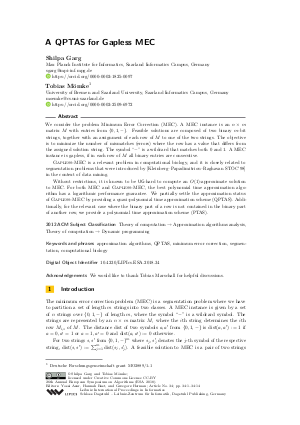A QPTAS for Gapless MEC
Authors
Shilpa Garg  ,
Tobias Mömke
,
Tobias Mömke 
-
Part of:
Volume:
26th Annual European Symposium on Algorithms (ESA 2018)
Part of: Series: Leibniz International Proceedings in Informatics (LIPIcs)
Part of: Conference: European Symposium on Algorithms (ESA) - License:
 Creative Commons Attribution 3.0 Unported license
Creative Commons Attribution 3.0 Unported license
- Publication Date: 2018-08-14
File

PDF
LIPIcs.ESA.2018.34.pdf
- Filesize: 494 kB
- 14 pages
Document Identifiers
Subject Classification
ACM Subject Classification
- Theory of computation → Approximation algorithms analysis
- Theory of computation → Dynamic programming
Keywords
- approximation algorithms
- QPTAS
- minimum error correction
- segmentation
- computational biology
Metrics
- Access Statistics
-
Total Accesses (updated on a weekly basis)
0Document
0Metadata
Abstract
We consider the problem Minimum Error Correction (MEC). A MEC instance is an n x m matrix M with entries from {0,1,-}. Feasible solutions are composed of two binary m-bit strings, together with an assignment of each row of M to one of the two strings. The objective is to minimize the number of mismatches (errors) where the row has a value that differs from the assigned solution string. The symbol "-" is a wildcard that matches both 0 and 1. A MEC instance is gapless, if in each row of M all binary entries are consecutive.
Gapless-MEC is a relevant problem in computational biology, and it is closely related to segmentation problems that were introduced by {[}Kleinberg-Papadimitriou-Raghavan STOC'98{]} in the context of data mining.
Without restrictions, it is known to be UG-hard to compute an O(1)-approximate solution to MEC. For both MEC and Gapless-MEC, the best polynomial time approximation algorithm has a logarithmic performance guarantee. We partially settle the approximation status of Gapless-MEC by providing a quasi-polynomial time approximation scheme (QPTAS). Additionally, for the relevant case where the binary part of a row is not contained in the binary part of another row, we provide a polynomial time approximation scheme (PTAS).
Cite As Get BibTex
Shilpa Garg and Tobias Mömke. A QPTAS for Gapless MEC. In 26th Annual European Symposium on Algorithms (ESA 2018). Leibniz International Proceedings in Informatics (LIPIcs), Volume 112, pp. 34:1-34:14, Schloss Dagstuhl – Leibniz-Zentrum für Informatik (2018)
https://doi.org/10.4230/LIPIcs.ESA.2018.34
BibTex
@InProceedings{garg_et_al:LIPIcs.ESA.2018.34,
author = {Garg, Shilpa and M\"{o}mke, Tobias},
title = {{A QPTAS for Gapless MEC}},
booktitle = {26th Annual European Symposium on Algorithms (ESA 2018)},
pages = {34:1--34:14},
series = {Leibniz International Proceedings in Informatics (LIPIcs)},
ISBN = {978-3-95977-081-1},
ISSN = {1868-8969},
year = {2018},
volume = {112},
editor = {Azar, Yossi and Bast, Hannah and Herman, Grzegorz},
publisher = {Schloss Dagstuhl -- Leibniz-Zentrum f{\"u}r Informatik},
address = {Dagstuhl, Germany},
URL = {https://drops.dagstuhl.de/entities/document/10.4230/LIPIcs.ESA.2018.34},
URN = {urn:nbn:de:0030-drops-94978},
doi = {10.4230/LIPIcs.ESA.2018.34},
annote = {Keywords: approximation algorithms, QPTAS, minimum error correction, segmentation, computational biology}
}
Author Details
Funding
- Mömke, Tobias: Deutsche Forschungsgemeinschaft grant MO2889/1-1
References
-
Noga Alon and Benny Sudakov. On two segmentation problems. Journal of Algorithms, 33(1):173-184, 1999.

-
Paola Bonizzoni, Riccardo Dondi, Gunnar W Klau, Yuri Pirola, Nadia Pisanti, and Simone Zaccaria. On the minimum error correction problem for haplotype assembly in diploid and polyploid genomes. Journal of Computational Biology, 2016.

- Rudi Cilibrasi, Leo van Iersel, Steven Kelk, and John Tromp. The Complexity of the Single Individual SNP Haplotyping Problem. Algorithmica, 49(1):13-36, aug 2007. URL: http://dx.doi.org/10.1007/s00453-007-0029-z.
-
Uriel Feige. NP-hardness of hypercube 2-segmentation. CoRR, abs/1411.0821, 2014.

- Pierre Fouilhoux and A. Ridha Mahjoub. Solving VLSI design and DNA sequencing problems using bipartization of graphs. Computational Optimization and Applications, 51(2):749-781, 2012. URL: http://dx.doi.org/10.1007/s10589-010-9355-1.
-
Shilpa Garg, Marcel Martin, and Tobias Marschall. Read-based phasing of related individuals. Bioinformatics, 32(12):i234-i242, 2016.

- Dan He, Arthur Choi, Knot Pipatsrisawat, Adnan Darwiche, and Eleazar Eskin. Optimal algorithms for haplotype assembly from whole-genome sequence data. Bioinformatics, 26(12):i183-i190, 2010. URL: http://dx.doi.org/10.1093/bioinformatics/btq215.
-
Yishan Jiao, Jingyi Xu, and Ming Li. On the k-closest substring and k-consensus pattern problems. In CPM, volume 3109 of Lecture Notes in Computer Science, pages 130-144. Springer, 2004.

-
Jon M. Kleinberg, Christos H. Papadimitriou, and Prabhakar Raghavan. Segmentation problems. In STOC, pages 473-482. ACM, 1998.

-
Jon M. Kleinberg, Christos H. Papadimitriou, and Prabhakar Raghavan. Segmentation problems. J. ACM, 51(2):263-280, 2004.

-
Danny Leung, Inkyung Jung, Nisha Rajagopal, Anthony Schmitt, Siddarth Selvaraj, Ah Young Lee, Chia-An Yen, Shin Lin, Yiing Lin, Yunjiang Qiu, et al. Integrative analysis of haplotype-resolved epigenomes across human tissues. Nature, 518(7539):350-354, 2015.

-
Ming Li, Bin Ma, and Lusheng Wang. Finding similar regions in many sequences. J. Comput. Syst. Sci., 65(1):73-96, 2002.

-
Rafail Ostrovsky and Yuval Rabani. Polynomial-time approximation schemes for geometric min-sum median clustering. J. ACM, 49(2):139-156, 2002.

- Murray Patterson, Tobias Marschall, Nadia Pisanti, Leo van Iersel, Leen Stougie, Gunnar W. Klau, and Alexander Schönhuth. WhatsHap: Weighted haplotype assembly for future-generation sequencing reads. Journal of Computational Biology, 22(6):498-509, feb 2015. URL: http://dx.doi.org/10.1089/cmb.2014.0157.
- Yuri Pirola, Simone Zaccaria, Riccardo Dondi, Gunnar W. Klau, Nadia Pisanti, and Paola Bonizzoni. HapCol: accurate and memory-efficient haplotype assembly from long reads. Bioinformatics, page btv495, aug 2015. URL: http://dx.doi.org/10.1093/bioinformatics/btv495.
-
Jan Remy and Angelika Steger. Approximation schemes for node-weighted geometric steiner tree problems. Algorithmica, 55(1):240-267, 2009.

-
Matthew W Snyder, Andrew Adey, Jacob O Kitzman, and Jay Shendure. Haplotype-resolved genome sequencing: experimental methods and applications. Nature Reviews Genetics, 16(6):344-358, 2015.

-
Ryan Tewhey, Vikas Bansal, Ali Torkamani, Eric J Topol, and Nicholas J Schork. The importance of phase information for human genomics. Nature Reviews Genetics, 12(3):215-223, 2011.

-
Sharon Wulff, Ruth Urner, and Shai Ben-David. Monochromatic bi-clustering. In ICML (2), volume 28 of JMLR Workshop and Conference Proceedings, pages 145-153. JMLR.org, 2013.

